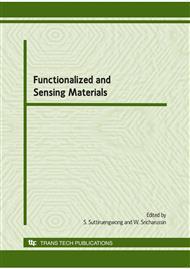p.13
p.17
p.22
p.27
p.31
p.35
p.39
p.43
p.49
Composite Polymer Electrolyte for Dye-Sensitized Solar Cells: Role of Multi-Walled Carbon Nanotubes
Abstract:
We focus on the energy conversion improvement of dye-sensitized solar cells by using poly(ethylene oxide)-multi-walled carbon nanotube (PEO-MWCNT) electrolyte. Compared with the MWCNT-free solar cells, the addition of 0.05 wt.% MWCNTs in the polymer electrolyte results in a dramatic increase of the short-circuit current (Jsc), consequently raising the device performance by approximately 9% under a direct light of the Air Mass 1.5 irradiation at 100 mW cm-2. The role of the conductive carbon materials in the polymer electrolyte have been investigated by means of ionic conductometry, electrochemical impedance spectroscopy and UV-visible spectroscopy. This work demonstrates that MWCNT additives in polymer electrolytes is a convenient yet effective strategy for improving the performance of photovoltaic devices.
Info:
Periodical:
Pages:
31-34
Citation:
Online since:
January 2010
Price:
Сopyright:
© 2010 Trans Tech Publications Ltd. All Rights Reserved
Share:
Citation:



